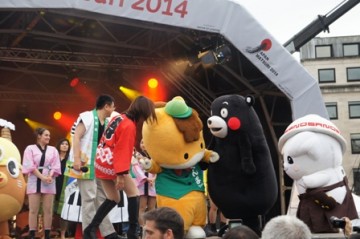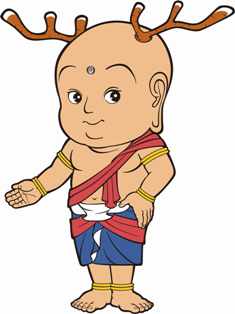 Kumamon, and the other ‘yurukyara’ represent a recent trend for mascot characters as a part of region promotion in Japan. With Japan known for its kawaii (cute) culture, local government has taken advantage in the rising global popularity of Japanese manga and anime which has seen an explosion in recent years, and is seen by Japan’s central government as a key tool of soft power in promoting Japan. Local authorities have spent considerable resources, with varying degrees of success, to create and market mascots both at home and overseas, in promoting the regions and their distinctiveness.
Kumamon, and the other ‘yurukyara’ represent a recent trend for mascot characters as a part of region promotion in Japan. With Japan known for its kawaii (cute) culture, local government has taken advantage in the rising global popularity of Japanese manga and anime which has seen an explosion in recent years, and is seen by Japan’s central government as a key tool of soft power in promoting Japan. Local authorities have spent considerable resources, with varying degrees of success, to create and market mascots both at home and overseas, in promoting the regions and their distinctiveness.
Kumamon was created in 2010 by the government of Kumamoto Prefecture for a campaign called ‘Kumamoto Surprise’ to draw tourists to the region after the Kyushu Shinkansen high speed train line opened. Kumamon subsequently became nationally popular, and was voted top in a nationwide survey of mascots in late 2011, gaining over 280,000 votes. Following this success in the contest, Kumamoto earned ¥11.8 billion (GB£79 million) in revenue through merchandising in the first half of 2012, beforehand earning ¥2.5 billion (GB£17 million) throughout all of 2011.
Kumamon’s popularity and brand presence is thought to stem from how he is the sole the representative of Kumamoto Prefecture, unlike other institutions and regions that have multiple characters vying for popularity. The Bank of Japan estimates that in the two years that he has been promoting Kumamoto that he has generated ¥123.2 billion (£677 million) in revenue.
Some of the other mascots have been met with a mixed reaction. Designed by famous sculptor and professor at Tokyo University of the Arts, Satoshi Yabuuchi, Sento-kun is an image of a young Buddha crowned with a pair of deer antlers. Deers are regarded as holy animals in Nara, appointed by the gods to guard the new capital when it was established in the area.
His design was at the time criticised as being disrespectful to Buddha and expensive, it also suffered a fatal flaw: it was not ‘kawaii’. Local residents even held their own competition to find a replacement which received over 600 entries.
 Despite his flaws, Sento-kun raised the equivalent of ¥22.5bn (£169m) in free publicity in 2010, according to the official estimates from the anniversary press office. He appeared in newspapers and magazines some 3,500 times and his total television coverage amounted to 32 hours and 40 minutes. Over 200 items adorned with Sento-kun’s image also went on sale, produced by companies both inside Nara and outside the prefecture, bringing in income from licensing of over ¥4.8bn.
Despite his flaws, Sento-kun raised the equivalent of ¥22.5bn (£169m) in free publicity in 2010, according to the official estimates from the anniversary press office. He appeared in newspapers and magazines some 3,500 times and his total television coverage amounted to 32 hours and 40 minutes. Over 200 items adorned with Sento-kun’s image also went on sale, produced by companies both inside Nara and outside the prefecture, bringing in income from licensing of over ¥4.8bn.
All of this was reflected in the increase of tourists who visited the restored palace of Heijokyo – the ancient capital of Japan. A total of 3.63m tourists visited the site between April and November 2010 which was up 45% on the original estimate. It has also been reported that 13.8m tourists also visited other sites in Nara up to October 2010, which exceeded the annual forecast of 10m. Sento-kun has presided over a sizeable increase in Nara’s tourism and is credited with raising Nara’s profile to the forefront of Japanese tourism. Despite the initial backlash, Nara Prefectural Government decided to keep him as a long-term mascot after 2010.
Region branding like this is not completely alien to the UK. One of the most successful examples was of course ‘Glasgow’s Miles Better’ campaign which used the Mr. Men character Mr. Happy, in a campaign to promote the city of Glasgow as a tourist destination and as a location for industry, and is regarded as one of the world’s earliest and most successful attempts to rebrand a city, receiving a number of domestic and international awards.
More information (in addition to mascots for promotion) on regions’ PR and branding can be found in JLGC’s website, in the case studies section
Sento-kun logo and homepage copyright ©2009 Association for Commemorative Events of the 1300th Anniversary of Nara Heijo-kyo Capital
Text and research on Sento-kun by Andrew Stevens and Phillippa Harvey

